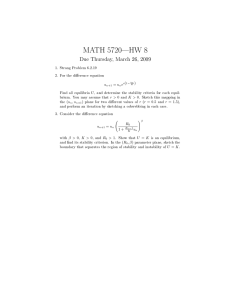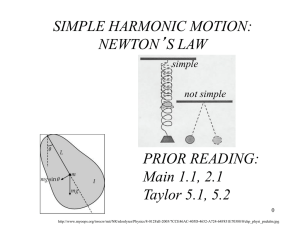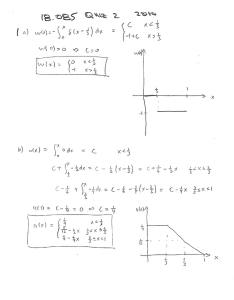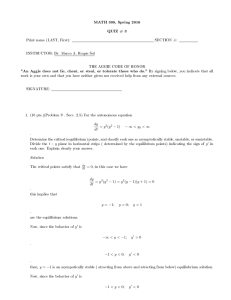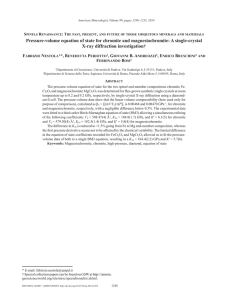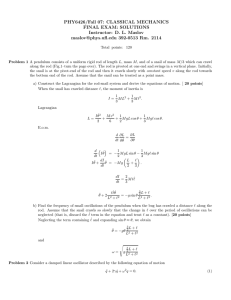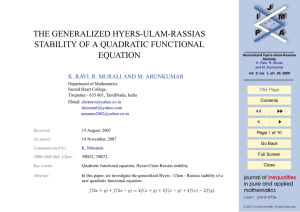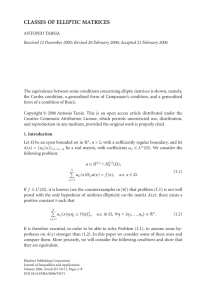STABILITY OF DIFFERENCE ANALOGUE OF LINEAR MATHEMATICAL INVERTED PENDULUM
advertisement
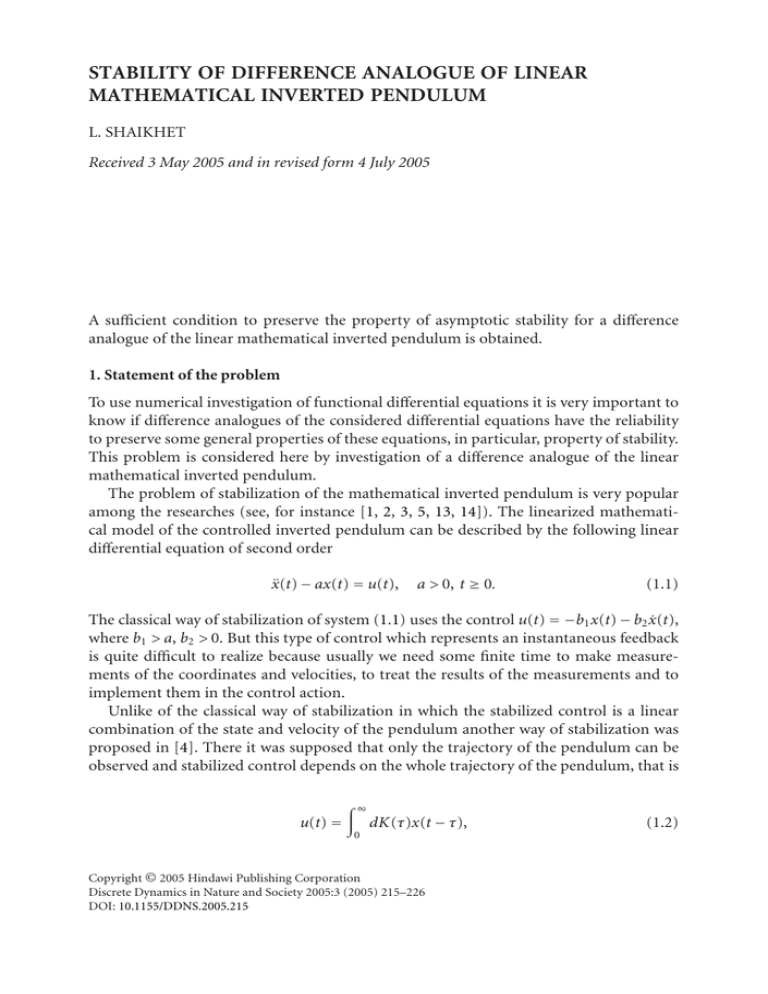
STABILITY OF DIFFERENCE ANALOGUE OF LINEAR
MATHEMATICAL INVERTED PENDULUM
L. SHAIKHET
Received 3 May 2005 and in revised form 4 July 2005
A sufficient condition to preserve the property of asymptotic stability for a difference
analogue of the linear mathematical inverted pendulum is obtained.
1. Statement of the problem
To use numerical investigation of functional differential equations it is very important to
know if difference analogues of the considered differential equations have the reliability
to preserve some general properties of these equations, in particular, property of stability.
This problem is considered here by investigation of a difference analogue of the linear
mathematical inverted pendulum.
The problem of stabilization of the mathematical inverted pendulum is very popular
among the researches (see, for instance [1, 2, 3, 5, 13, 14]). The linearized mathematical model of the controlled inverted pendulum can be described by the following linear
differential equation of second order
ẍ(t) − ax(t) = u(t),
a > 0, t ≥ 0.
(1.1)
The classical way of stabilization of system (1.1) uses the control u(t) = −b1 x(t) − b2 ẋ(t),
where b1 > a, b2 > 0. But this type of control which represents an instantaneous feedback
is quite difficult to realize because usually we need some finite time to make measurements of the coordinates and velocities, to treat the results of the measurements and to
implement them in the control action.
Unlike of the classical way of stabilization in which the stabilized control is a linear
combination of the state and velocity of the pendulum another way of stabilization was
proposed in [4]. There it was supposed that only the trajectory of the pendulum can be
observed and stabilized control depends on the whole trajectory of the pendulum, that is
u(t) =
∞
0
dK(τ)x(t − τ),
Copyright © 2005 Hindawi Publishing Corporation
Discrete Dynamics in Nature and Society 2005:3 (2005) 215–226
DOI: 10.1155/DDNS.2005.215
(1.2)
216
Stability of inverted pendulum
where the kernel K(τ) is a function of bounded variation on [0,∞] and the integral is
understood in the Stiltjes sense. It means, in particular, that both distributed and discrete delays can be used depending on the concrete choice of the kernel K(τ). The initial
condition for the system (1.1), (1.2) has the form
x(s) = ϕ(s),
ẋ(s) = ϕ̇(s),
s ≤ 0,
(1.3)
where ϕ(s) is a given continuously differentiable function.
Definition 1.1. The trivial solution of system (1.1)–(1.3) is called stable if for any > 0
there exists δ > 0 such that max{|x(t)|, |ẋ(t)|} < for all t ≥ 0 if ϕ = sups≤0 (|ϕ(s)| +
|ϕ̇(s)|) < δ. If, besides, limt→∞ x(t) = 0 and limt→∞ ẋ(t) = 0 for every initial function ϕ,
then the trivial solution of system (1.1)–(1.3) is called asymptotically stable.
Put
a1 = −a − k0 ,
ki =
∞
0
i
τ dK(τ),
k2 =
i = 0,1,
∞
0
τ 2 dK(τ).
(1.4)
Theorem 1.2 (see [4]). Let
a1 > 0,
k2 < km =
k1 > 0,
4
1+ 1+
(1.5)
1 + a1 /k1
2 .
(1.6)
Then the trivial solution of system (1.1)–(1.3) is asymptotically stable.
It is shown also [4] that inequalities (1.5) are necessary conditions for asymptotic stability of the trivial solution of system (1.1)–(1.3) but inequality (1.6) is only sufficient
one.
Below the mathematical model of the controlled inverted pendulum (1.1)–(1.3) is
considered in the following simple form
ẍ(t) − ax(t) = b1 x t − h1 + b2 x t − h2 ,
t ≥ 0.
(1.7)
Here a > 0, b1 , b2 , h1 > 0, h2 > 0 are given arbitrary numbers. From (1.4) it follows that
for equation (1.7)
k0 = b1 + b2 ,
k1 = b1 h1 + b2 h2 ,
k2 = b1 h21 + b2 h22 .
(1.8)
The main conclusion of our investigation here can be formulated in the following way:
if conditions (1.5), (1.6) hold then the trivial solution of equation (1.7) is asymptotically
stable and there exists enough small step of discretization of this equation that the trivial
solution of the corresponding difference equation is asymptotically stable too.
Note, that the conditions for asymptotic stability are obtained here by virtue of Kolmanovskii and Shaikhet’s general method of Lyapunov functionals construction [6, 7, 8,
9, 10, 11, 12, 15] which is applicable for both differential and difference equations, both
for deterministic and stochastic systems with delay.
L. Shaikhet 217
2. Construction of difference analogue
Transform equation (1.7) to a system of the equations
ẋ(t) = y(t),
ẏ(t) = ax(t) +
2
bl x(t − hl ).
(2.1)
l =1
To construct a difference analogue of system (2.1) put
xi = x ti ,
ti = iτ,
h1 = m1 τ,
h2 = m2 τ,
τ > 0.
(2.2)
A difference analogue of system (2.1) can be considered in the form
xi+1 = xi + τ yi ,
yi+1 = yi + τ axi +
2
bl xi−ml .
(2.3)
l=1
From the first equation of system (2.3) we have
xi = xi−ml + τ
i−1
l = 1,2.
yi ,
(2.4)
j =i−ml
From here and (1.8) it follows
2
2
bl xi−ml = k0 xi − τ
l=1
bl
i −1
yi .
(2.5)
j =i−ml
l=1
Substituting (2.5) into the second equation of system (2.3) and using (1.4) we obtain
yi+1 = yi − τa1 xi − τ 2
2
bl
i−1
yj.
(2.6)
j =i−ml
l=1
Put
Fi = τ 2
2
i−1
bl
l=1
q1 = b1 m1 + b2 m2 = τ −1 k1 .
j − i + 1 + ml y j ,
(2.7)
j =i−ml
Calculating ∆Fi = Fi+1 − Fi , we have
∆Fi = τ
2
2
bl
=τ
2
bl ml yi −
i −1
j − i + ml y j −
j =i+1−ml
l=1
2
i
i −1
yi = τ k1 yi − τ
j − i + 1 + ml y j
j =i−ml
j =i−ml
l=1
2
bl
l =1
i−1
(2.8)
yj .
j =i−ml
From here and (2.6) it follows
yi+1 = −τa1 xi + 1 − τk1 yi + ∆Fi .
(2.9)
218
Stability of inverted pendulum
So, system (2.3) can be written in the matrix form
z(i + 1) = Az(i) + ∆F(i),
(2.10)
where
xi
,
z(i) =
yi
0
F(i) =
,
Fi
1
A=
−τa1
τ
.
1 − τk1
(2.11)
3. Stability conditions of the auxiliary equation
Following the general method of Lyapunov functionals construction [7] at first consider
the auxiliary equation
z(i + 1) = Az(i)
(3.1)
which can be written in a scalar form
xi+2 = A0 xi+1 + A1 xi
(3.2)
with
A0 = 2 − τk1 ,
A1 = τ(k1 − τa1 ) − 1.
(3.3)
It is well known [15] that necessary and sufficient conditions for asymptotic stability
of the trivial solution of equation (3.2) have the form
|A1 | < 1,
|A0 | < 1 − A1 .
(3.4)
For A1 from (3.3), (3.4) it follows 0 < τ(k1 − τa1 ) < 2. It means that
τ ∈ 0,
k1
,
a1
if k12 < 8a1 ,
(3.5)
k1 + k12 − 8a1 k1
k1 − k12 − 8a1
∪
,
,
τ ∈ 0,
2a1
2a1
a1
if k12 ≥ 8a1 .
For A0 from (3.3), (3.4) it follows a1 τ 2 − 2k1 τ + 4 > 0. It means that
if k12 < 4a1 ,
τ ∈ (0, ∞),
k1 + k12 − 4a1
k1 − k12 − 4a1
τ ∈ 0,
∪
,∞ ,
a1
a1
if k12 ≥ 4a1 .
(3.6)
As a result we obtain necessary and sufficient conditions for asymptotic stability of the
trivial solution of auxiliary equation (3.2) in the form
1
a−
1 k1 ,
0<τ < a−1 k1 − k 2 − 4a1 ,
1
1
k12 < 4a1 ,
k12 ≥ 4a1 .
(3.7)
L. Shaikhet 219
Note that if for arbitrary positive definite matrix C the matrix equation
A DA − D = −C.
(3.8)
has a positive definite solution D then the function v(i) = z (i)Dz(i) is a Lyapunov function for equation (3.1), that is ∆v(i) = −z (i)Cz(i).
Let matrix C be a diagonal matrix with positive elements c1 and c2 . Then the elements
di j of the matrix D satisfy the system of the equation
τ 2 a21 d22 − 2τa1 d12 = −c1 ,
d11 − τa1 + k1 d12 − a1 1 − τk1 d22 = 0,
2
(3.9)
τ d11 + 2τ 1 − τk1 d12 − τk1 2 − τk1 d22 = −c2 ,
with the solution
2 − τ k1 − a1 τ
c1 a1 τ + k1
+
a1 d22 ,
2a1 τ
2
c1 2 − τ k1 − a1 τ + 2a1 c2
τa
c
.
d12 = 1 + 1 d22 , d22 =
2τa1
2
τa1 k1 − a1 τ 4 − τ 2k1 − a1 τ
d11 =
(3.10)
Remark 3.1. Note that without loss of generality in (3.10) we can put c1 = 1, c2 = c. Really,
if it is not so we can divide matrix equation (3.8) on c1 . As a result we obtain a new
diagonal matrix C with the elements 1 and c = c2 /c1 and a new matrix D with the elements
a1 τ + k1 2 − τ k1 − a1 τ
+
a1 d22 ,
2a1 τ
2
2 − τ k1 − a1 τ + 2a1 c
τa1
1
.
d12 =
+
d22 , d22 =
2τa1
2
τa1 k1 − a1 τ 4 − τ 2k1 − a1 τ
d11 =
(3.11)
Remark 3.2. It is easy to check that by condition (3.7) the matrix D with elements (3.11)
is a positive definite one.
4. Stability conditions of the difference analogue
Let us obtain now a sufficient condition for asymptotic stability of the trivial solution of
(2.10). Transform this equation to the form
z(i + 1) − F(i + 1) = Az(i) − F(i).
(4.1)
Following the general method of Lyapunov functionals construction [7] we will construct
Lyapunov functional Vi for equation (2.10) in the form Vi = V1i + V2i , where
V1i = z(i) − F(i) D z(i) − F(i)
and the matrix D is a positive definite solution of matrix equation (3.8).
(4.2)
220
Stability of inverted pendulum
Calculating ∆V1i via (4.2), (4.1), (3.8) we have
∆V1i = z(i + 1) − F(i + 1) D z(i + 1) − F(i + 1)
− z(i) − F(i) D z(i) − F(i)
= Az(i) − F(i) D Az(i) − F(i) − z(i) − F(i) D z(i) − F(i)
(4.3)
= −z (i)Cz(i) − 2F (i)D(A − I)z(i).
Note that
2F (i)D(A − I)z(i)
=2 0
Fi
d
11
= 2Fi d12
d12
d22
d12
d22
0
−τa1
τ
−τk1
xi
yi
τ yi
−τ a1 xi + k1 yi
(4.4)
= 2Fi − τa1 d22 xi + τ d12 − k1 d22 yi
= −2τa1 d22 xi Fi + 2τ d12 − k1 d22 yi Fi .
Put
2 − τ k1 − a1 τ + 2a1 c
.
α= k1 − a1 τ 4 − τ 2k1 − a1 τ
(4.5)
Then from (3.11), (4.5) it follows
d22 =
α
.
τa1
(4.6)
Using (3.11), (4.5), (4.6) we obtain
1 1 − α 2k1 − a1 τ
2a1
2k1 − a1 τ 2 − τ k1 − a1 τ + 2a1 c
1
1−
= −β,
=
2a1
k1 − a1 τ 4 − τ 2k1 − a1 τ
τ d12 − k1 d22 =
(4.7)
where
τ + c 2k1 − a1 τ
.
β= k1 − a1 τ 4 − τ 2k1 − a1 τ
(4.8)
So, via Remark 3.1, (4.3), (4.4), (4.6), (4.7)
∆V1i = −xi2 − cyi2 − 2αxi Fi − 2βyi Fi .
(4.9)
Put now
1 bl ml ml + 1 ,
2 l=1
2
q2 =
Si =
2
i−1
bl j − i + 1 + ml y 2j .
l=1
j =i−ml
(4.10)
L. Shaikhet 221
Using (2.7) and λ1 > 0 we have
2xi Fi = 2τ 2
2
i −1
bl
j =i−ml
l=1
≤τ
2
2
l=1
j − i + 1 + ml x i y j
(4.11)
i−1
1
τ2
bl j − i + 1 + ml λ1 xi2 + y 2j = λ1 τ 2 q2 xi2 + Si
λ1
j =i−ml
λ1
and analogously
τ2
Si ,
λ2
2yi Fi ≤ λ2 τ 2 q2 yi2 +
λ2 > 0.
(4.12)
As a result we obtain
∆V1i ≤ − 1 − ατ 2 λ1 q2 xi2 − c − βτ 2 λ2 q2 yi2 + ρSi ,
(4.13)
where
ρ = τ2
α β
+
.
λ1 λ2
(4.14)
To neutralize the positive component in the estimate for ∆V1i choose V2i in the form
V2i =
2
i−1
ρ
3
bl j − i + + ml
2 l=1
2
j =i−ml
2
1 bl 1 + ml
2 l =1
2
2
y 2j ,
q3 =
2
.
(4.15)
Calculating ∆V2i , we obtain
2
ρ
bl ∆V2i =
2 l=1
=
2
ρ
bl 2 l=1
j =i+1−ml
+
2
ρ
bl =
2 l=1
i
= ρq3 yi2 − ρ
1
+ ml
2
1
j − i + + ml
2
2
i−1 j −i+
2
8
i −1 j =i−ml
3
j − i + + ml
2
1
+ ml
2
2
2
y 2j
2 3
− j − i + + ml
y 2j
2
i −1
yi2 −
2
1 2
bl y
l=1
y 2j −
1
yi2 − yi2−ml
4
j =i−ml
1
+ ml
2
2
1 2
j − i + 1 + ml y 2j
yi−ml − 2
4
j =i−ml
i−ml +
i −1
j =i−ml
(4.16)
j − i + 1 + ml y 2j ≤ ρq3 yi2 − ρSi .
Thus, for the functional Vi = V1i + V2i we have
∆Vi ≤ − 1 − ατ 2 λ1 q2 xi2 − c − βτ 2 λ2 q2 − ρq3 yi2 .
(4.17)
222
Stability of inverted pendulum
Using (4.14) we obtain the stability conditions in the form
τ 2 αλ1 q2 < 1,
τ 2 βλ2 q2 + τ 2 q3
α β
+
λ1 λ2
< c.
(4.18)
To minimize the left-hand part of the second condition (4.18) put λ2 = q3 /q2 . Then
(4.18) takes the form
αq3
τ2
2β q2 q3 +
< 1.
c
λ1
τ 2 αλ1 q2 < 1,
(4.19)
Choosing λ1 > 0 from the condition
αλ1 q2 =
αq3
1
2β q2 q3 +
,
c
λ1
(4.20)
we obtain
√
λ1 =
q3 β + β2 + α2 c
√
.
αc q2
(4.21)
Substituting (4.21) into (4.19) we get stability condition in the form
γ = τ 2 q2 q3 .
γ β + β2 + α2 c < c,
(4.22)
From here it follows
γ γα2 + 2β < c.
(4.23)
Put
ki =
2
i
bl h ,
l =1
l
i = 0,1,2.
(4.24)
Then
1 bl hl τ + hl = 1 τ k1 + k2 ,
2 l=1
2
2
q2 τ 2 =
1 bl τ + hl
q3 τ =
2 l=1
2
2
2
2
1 τ2 =
k0 + τ k1 + k2 .
2 4
(4.25)
L. Shaikhet 223
Therefore,
1
γ=
2
τ k1 + k2
τ2
k0 + τ k1 + k2 .
(4.26)
β = B −1 (τ + Gc),
(4.27)
4
Using dependence α and β on c put
α = B −1 A + 2a1 c ,
where
A = 2 − τ k1 − a1 τ ,
B = k1 − a1 τ (4 − Gτ),
G = 2k1 − a1 τ.
(4.28)
Substituting (4.27) into (4.23) we obtain
γB −2
A2 γ + 2Bτ
+ 4γa21 c + 4Aγa1 + 2BG < 1.
c
(4.29)
After minimization of the left-hand part of (4.29) with respect to c > 0 one can rewrite
(4.29) in the form
δ(τ) = 2γB −2 2a1 γ(A2 γ + 2Bτ) + 2Aγa1 + BG < 1.
(4.30)
One has remember that in condition (4.30) a1 is defined by (1.2), A, B, G are defined by
(4.28) and γ is defined by (4.26), (4.24). So, A, B, G and γ depend on τ.
Thus, the following theorem is proven.
Theorem 4.1. Let conditions (1.5) hold and the step of quantization τ > 0 satisfies condition
(4.30). Then the trivial solution of system (2.3) is asymptotically stable.
Lemma 4.2. If condition (1.6) holds then there exists enough small τ > 0 that condition
(4.30) holds too.
Proof. For τ = 0 condition (4.30) takes the form
k2 < 4 1 +
1+
4a1
k12
−1
.
(4.31)
It is easy to see that if condition (1.6) holds then condition (4.31) (or condition (4.30)
for τ = 0) holds too. Since the function δ(τ) is continuous in the point τ = 0 then if
condition (4.30) holds for τ = 0 then it holds for enough small τ > 0 also. The proof is
completed.
Corollary 4.3. Let conditions (1.5), (1.6) hold then there exists enough small τ > 0 that
the trivial solution of system (2.3) is asymptotically stable.
5. Numerical analysis
Here we consider some numerical examples which illustrate the theoretical results obtained above. For illustration of Corollary 4.3 consider the following example.
224
Stability of inverted pendulum
x(t)
40
30
20
10
−5 0
−15
−25
−35
20
40
60
80
100 120 140 160 180 200
t
Figure 5.1
16
12
8
x(t)
4
−20
−6
120 240 360 480 600 720 840 960 1080 1200
t
−10
−14
Figure 5.2
Example 5.1. Put in equation (1.7) a = 9.5, b1 = 10, b2 = −20, h1 = 0.4, h2 = 0.02. Then
a1 = 0.5 > 0, k1 = 3.6 > 0, k2 = 1.608 < km = 1.92. Conditions (1.5), (1.6) hold, therefore (Theorem 1.2), the trivial solution of equation (1.7) is asymptotically stable. Besides
there exists enough small τ > 0 that condition (4.30) holds. Using τ = 0.01 we obtain
δ(0.01) = 0.869 < 1, that is condition (4.30) holds. Therefore, the trivial solution of difference system (2.3) is asymptotically stable. On Figure 5.1 it is shown that the trajectory
of solution of system (2.3) with the initial condition x j = 33, j ≤ 0, y0 = 0 goes to zero.
If conditions (1.5) hold but condition (1.6) does not hold then the trivial solution
of equation (1.7) can be asymptotically stable or unstable. If in this case for some τ > 0
condition (4.30) does not hold too then the trivial solution of difference system (2.3) can
be also asymptotically stable or unstable. In the following two examples one can see the
both situations.
Example 5.2. Put in equation (1.7) a = 3, b1 = 1, b2 = −5, h1 = 0.55, h2 = 0.1. Then a1 =
1 > 0, k1 = 0.05 > 0, k2 = 0.3525 > km = 0.0975, δ(0.01) = 20.83 > 1. So, conditions (1.5)
hold but conditions (1.6) and (4.30) do not hold. On Figure 5.2 it is shown that the
trajectory of solution of system (2.3) with the initial condition x j = 12, j ≤ 0, y0 = 0 goes
to zero.
x(t)
L. Shaikhet 225
72
54
36
18
−90
−27
−45
−63
60
120 180 240 300 360 420 480 540 600
t
Figure 5.3
Example 5.3. Putting in the previous example h1 = 0.53 (without changing the values
of the other parameters) we obtain a1 = 1 > 0, k1 = 0.03 > 0, k2 = 0.3309 > km = 0.0591,
δ(0.01) = 73.06 > 1. As in the previous example conditions (1.5) hold, conditions (1.6)
and (4.30) do not hold but in this case the trajectory of solution of system (2.3) with the
initial condition x j = 12, j ≤ 0, y0 = 0 goes to infinity (Figure 5.3).
References
[1]
[2]
[3]
[4]
[5]
[6]
[7]
[8]
[9]
[10]
[11]
[12]
[13]
D. J. Acheson, A pendulum theorem, Proc. Roy. Soc. London Ser. A 443 (1993), no. 1917, 239–
245.
D. J. Acheson and T. Mullin, Upside-down pendulums, Nature 366 (1993), no. 6452, 215–216.
J. A. Blackburn, H. J. T. Smith, and N. Grønbech-Jensen, Stability and Hopf bifurcations in an
inverted pendulum, Amer. J. Phys. 60 (1992), no. 10, 903–908.
P. Borne, V. B. Kolmanovskii, and L. E. Shaikhet, Stabilization of inverted pendulum by control
with delay, Dynam. Systems Appl. 9 (2000), no. 4, 501–514.
P. L. Kapitza, Dynamical stability of a pendulum when its point of suspension vibrates, and Pendulum with a vibrating suspension, In Collected Papers of P. L. Kapitza (D. ter Haar, ed.),
vol. 2, Pergamon Press, London, 1965, pp. 714–737.
V. B. Kolmanovskii and L. E. Shaikhet, New results in stability theory for stochastic functionaldifferential equations (SFDEs) and their applications, Proceedings of Dynamic Systems and
Applications, Vol. 1 (Atlanta, GA, 1993), Dynamic, Georgia, 1994, pp. 167–171.
, General method of Lyapunov functionals construction for stability investigation of stochastic difference equations, Dynamical Systems and Applications, World Sci. Ser. Appl.
Anal., vol. 4, World Scientific Publishing, New Jersey, 1995, pp. 397–439.
, Method for constructing Lyapunov functionals for stochastic differential equations of neutral type, Differential Equations 31 (1995), no. 11, 1819–1825.
, Construction of Lyapunov functionals for stochastic hereditary systems: a survey of some
recent results, Math. Comput. Modelling 36 (2002), no. 6, 691–716.
, Some peculiarities of the general method of Lyapunov functionals construction, Appl.
Math. Lett. 15 (2002), no. 3, 355–360.
, About one application of the general method of Lyapunov functionals construction, Internat. J. Robust Nonlinear Control 13 (2003), no. 9, 805–818, Special Issue on Time Delay
Systems.
, About some features of general method of Lyapunov functionals construction, Stab. Control Theory Appl. 6 (2004), no. 1, 49–76.
M. Levi, Stability of the inverted pendulum—a topological explanation, SIAM Rev. 30 (1988),
no. 4, 639–644.
226
[14]
[15]
Stability of inverted pendulum
M. Levi and W. Weckesser, Stabilization of the inverted linearized pendulum by high frequency
vibrations, SIAM Rev. 37 (1995), no. 2, 219–223.
L. E. Shaikhet, Necessary and sufficient conditions of asymptotic mean square stability for stochastic linear difference equations, Appl. Math. Lett. 10 (1997), no. 3, 111–115.
L. Shaikhet: Department of Higher Mathematics, Donetsk State University of Management,
Chelyuskintsev 163-a, Donetsk 83015, Ukraine
E-mail addresses: leonid@dsum.edu.ua; leonid.shaikhet@usa.net
